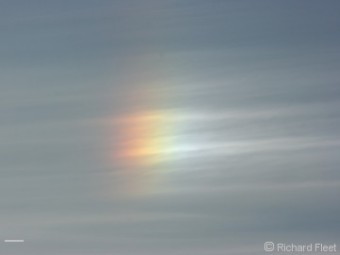|
Ice crystals are weakly birefringent which means that the sunlight is split into two paths travelling in slightly different directions, but with opposite polarisations.
Although this creates two separate sundogs the difference in direction is small, little more than a tenth of a degree.
This is somewhat less than the width of the colour bands so the effect is just to overlap the colours slightly.
However, using a polariser the sundogs from the two paths can be viewed separately and in a strong sundog the shift in position is quite easy to see, roughly a quarter of a moon diameter.
Looking through a polarising filter and quickly rotating it through 90 degrees shows the sundog rocking from side to side.
Cloud detail can be a useful reference but even in the 5 seconds it takes to change the filter position on a camera the background cloud can move more than the image shift, which makes the effect less obvious.
These pairs of images of a right sundog show the filter rotated one way then the other to show the difference, a tripod was used to ensure the camera did not move.
The exposures for all 4 images were the same but there is a noticeable shift in colour balance due to the weak polarisation of the background sky, the sun altitude 11 degrees.
The orientation of the polariser is shown at the bottom left of each image.
Click here to change angle of polariser
|

|

|
|
Switching from horizontal to vertical polarisation moves the sundog image to the right, which also happens to be the direction of cloud movement.
|
Taken 30 seconds later and switching from vertical to horizontal polarisation moves the sundog image to the left, which confirms the shift is not caused by cloud motion.
|
|
Note:
Your browser may need to be set to allow a short script to run.
The purpose of the script is to switch the images quickly.
|
Canon EOS 400D 18th July 2007
Wiltshire, England






